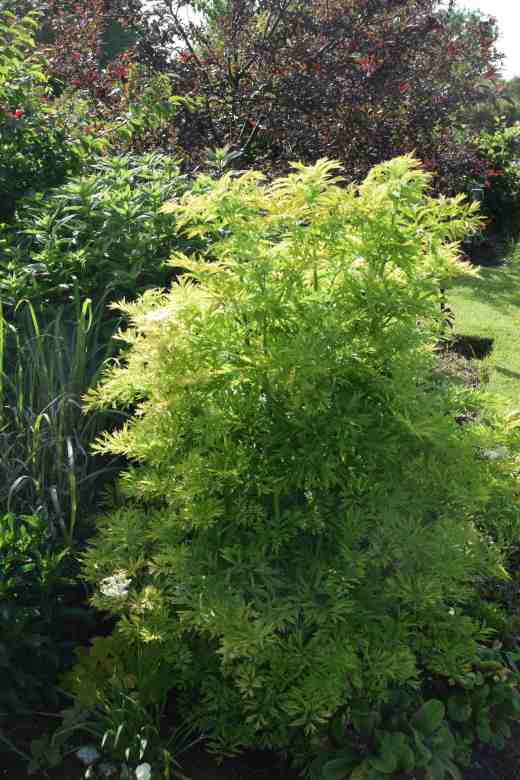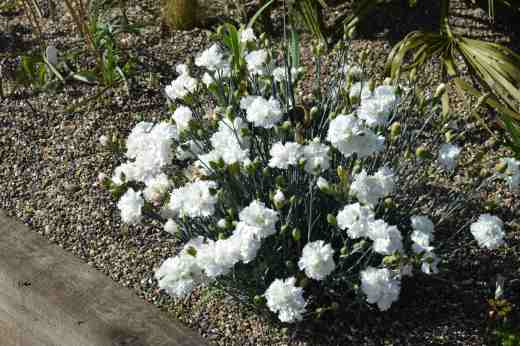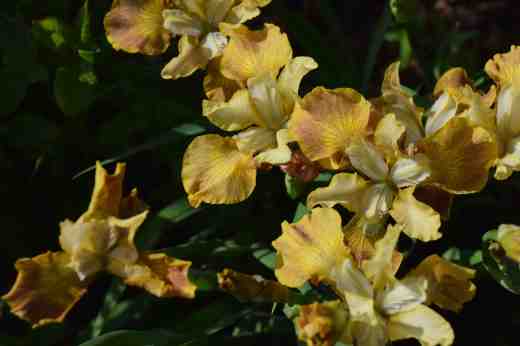A second look at some plants

It has been another busy week in the garden despite showery and, in the past two days, extremely windy weather. The guys putting up the solar panels were back for a third day yesterday and we still have no panels up. I can’t stay in the house while it sounds like fang-toothed, sickle-clawed demons are ripping off the roof so I have had to be outside, avoiding ever looking back at the house. It meant that the last of the patio pots were planted and I finally got the waterlilies potted on and moved to the big pond. It is a hateful job and it takes ages to get the ‘pond smell’ off your hands and arms. It is remarkable how they vary in growth rate and in habit, some making enormous rhizomes that had escaped the original pots while others are neat clumps. Those with a rangy habit were really difficult to get out of the pond, being inextricably mixed with pond weed. Most were repotted into large baskets and should be fine for two years.
I was delighted to find a couple of empty cases of dragonfly nymphs as I was rummaging around so I know that they are breeding in the small, lower pond. I have now planted some iris and dwarf reedmace in the pond so it should be perfect for dragonfly now.
But back to the plants. Above is Sambucus ‘Golden Tower’ which was put in two years ago. In fact there are two. It is a recent introduction with an upright habit and lime green to lemon yellow leaves. They are not really golden, which is fine by me in the place they are planted. It showed promise in the first year with upright growth and bright foliage which did not seem to burn in sun.

They have not been pruned at all and have a pleasant, upright habit but are bushy too. ‘Black Tower’ (which I also have as a very small plant, though I have grown it elsewhere) is rather gaunt, at least when a few years old. But ‘Golden Tower’ is a much more pleasant plant. I like everything about it and I think it is a good garden plant. The flowers are pretty typical of Sambucus nigra and I assume the fruit will be black – but I will have to wait to find out as this is the first year it has bloomed. After two years they are about 1.2m high.
They are planted in far from perfect soil that is rather wet in winter.

Geoff’s rating
9/10 – there is nothing not to like

I wrote about heuchera ‘Pinky Panky’ earlier this year. I was not sure if such a vividly coloured plant would have the vigour to grow in the garden. Many of the most fabulous heucheras look great when you buy them or grow them in pots of soft and fluffy multipurpose compost but then disappoint when forced to endure garden conditions. But ‘Pinky Panky’ has surprised me, so far, by putting up with winter cold and a dry spring in a new bed that was improved but is far from perfect. The foliage is a bright blend of greys and pinks and now it is in bloom it is hard to ignore. The flowers are usually described as ‘pink’ but they are a deep pink bordering on red. I am not sure if the combination is ‘lovely’ and this is a hard plant to place effectively because it is so ridiculously bright. But it provides colour and is at least moderately vigorous so I must be kind to it.
Geoff’s rating
8/10 – I am still not sure if I am brave enough to love it

Dianthus ‘Memories’ is a plant that I have been praising from the moment I first saw it – or should I say sniffed. I was impressed by the strong fragrance and by the wonderful steely foliage that sets off the flowers perfectly. It is perennial, unlike lots of the seed-raised kinds for sale right now, and it blooms throughout summer like most hybrid pinks. I must admit a strong liking for pinks and I have quite a few but only if they are fragrant.

If I have one criticism it is that the habit is rather compact so it is not the best for cutting. This is both a virtue and a fault because I love to cut them for the house, but since it makes it a fine garden plant I won’t hold it against it. I originally fell in love with this plant because I thought it was a great replacement for the much-loved ‘Mrs Sinkins’ which flowers just once but also splits its calyces so the flowers are frequently lop-sided. It is a worthy replacement and a far better garden plant, though the historical importance of the older pink means it should not be forgotten.
Geoff’s rating
10/10

My collection of pinks is rather random. Many have died out over the past two years because they were not in the right spot as the garden was developing and plants had to be planted out of necessity. But ‘Devon Wizard’ has done well and, as a result, I take lots of cuttings, and they are being popped into lots of places. It, and ‘Doris’ are the most planted in the garden so far. What makes this one so special is the steely foliage, the bright flowers and, most impressively, the amazing fragrance. The garden has not had many visitors but the few that have been here all comment on the spicy, clove scent because, unusually, it is produced so strongly that it wafts across the garden, catching you unawares as you wander round. It is an upright plant and ideal for cutting too. It also blooms for a very long time, being tough and hardy. There are usually a few flowers in April and they will continue into October.
Geoff’s rating
10/10 – but the colour is a bit uncompromising

Two years ago, when the hosta garden was planted, I added a few Siberian iris. Some have done well and other less so. After slowly building up to a good clump, ‘Flying Fiddles’ has now decided to show me what it can do and is a neat clump of fascinating flowers. It is shorter than some, a big advantage over the past two stormy days, and the flowers are only of moderate size. It was introduced in 2010 and should grow to about 80cm though my clump is shorter than that, at about 50cm. It is supposed to be fragrant but, despite bending down and having a good sniff, I can detect only the merest hint of any scent so I think this is irrelevant.

Descriptions also mention a violet shading to the style arms (in the centre of the flowers) but my flowers show none of this. But colours vary with flower age and temperature so I will keep watching for this, not that the flowers need any more shades. The stems have one branch and two flowers in the top socket so I assume, and hope, it will be in bloom for a good time. As a robust and novel Sib it seems to be a success.
Geoff’s rating
9/10 – great habit and interesting colour to get creative with
The elder looks good!
All sound gr8 & of course I want them all! What I do have A surfeit of is a pond oxygenator particularly for a small pond – I’m afraid I’ve lost the name, but it came from a pond specialist & was quite pricey. It’s in a couple of buckets – interested?
I wonder what that plant is? I would love to have a sprig of that – anything different in the pond is good. I have various areas and habitats from slow-moving to still water to try and please as many plants as possible. Thank you.
I will take a photo and email – tomorrow!
Ps I have a green cut leaved elder which is good. You might like a cutting of for a boundary area.
Perhaps it is ‘Laciniata’. A nice plant. Thank you
Do you coppice your elderberries? I prune mine by ‘alternating canes’. I prune out canes that have bloomed and fruited, but leave those that grew in the previous year. However, I have noticed that some that grew in the previous year have also bloomed and fruited. I suppose that ‘alternating canes’ is better than coppicing because the canes are more productive in their second year (or the new growth that grows from them is). I have not tried coppicing yet. In all of the many acres of landscape here, there is only a single ornamental elderberry, which we believe to be ‘Black Lace’. Because it is an ornamental specimen, I will not coppice it. It responds to the ‘alternating canes’ method of pruning splendidly, with richly bronzed new foliage and abundant bloom. The berries are not harvested because they are rather appealing until the birds take them. The common blue elderberry grows wild and abundantly though. They provide all the berries I want. The most productive specimens are not within the landscapes. I prune them only to promote fruit production. However, because they are somewhat abundant, I could try coppicing some of them instead of ‘alternating canes’.
I do not coppice these although I have, in the past, pruned Black Lace hard every spring to encourage strong growth with the largest leaves. I think that it is wise to cut out a few of the oldest stems every now and then to prevent the spread of the plant anyway. My current black lace has not been pruned by they are only a few years old and I am enjoying the flowers right now – may be making cordial in the next few days.